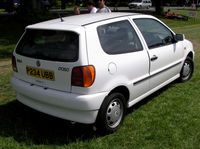Supermini car
Car Show
Supermini car
 1996 Volkswagen Polo, a popular modern European supermini
1996 Volkswagen Polo, a popular modern European superminiA supermini
is a European
hatchback
car
category. In the
United States these are more often known as
subcompacts. To be a supermini, the length of the car should be around 3.90
metres (12.8 ft) and have seating for four adults and a child. The first
superminis were the 1957 Fiat 500 and the 1959 Austin Mini. In 2004, the best
selling cars in Belgium, the Czech Republic, Denmark, France, Greece, Italy, the
Netherlands and Portugal
were all superminis. Overall in 2005, of the fifteen best selling types of car
in Europe, six were superminis.
History
50s and 60s
In Europe, the first supermini is considered to be the Italian Fiat 500 of
1957. The design was further popularized by the British Austin Mini two
years later (from which the class takes its name).
The Mini was the first successful mass production mini-car in Europe, going
on sale in 1959 as the Austin Seven or Morris Mini Minor. It was the only major
choice in the mini-car sector until the Rootes Group launched its rear-engined
Hillman Imp four years later. Around the same time, an Italian rival - the Fiat
500 - was also launched. Throughout the 1960s and 1970s, the Mini was a huge
successful for the BMC and later BL combines which produced it. The Fiat 500
remained hugely popular in Italy until production finally halted in 1974. Mini
sales began to fall after 1980 following the launch of the Austin Metro, a
larger and more modern alternative to the Mini, but it actually outlived its
'replacement' and remained on sale until it was finally replaced by the totally
redesigned BMW MINI in 2001. During that
time the Mini took its place as one of the most iconic cars of all time.
70s - oil crisis
By the 1970s, small cars were getting bigger and hatchback bodystyles were
favoured over the traditional saloon. The 1973 oil crisis forced buyers to
choose more economical, less powerful, lighter cars, The first successful
compact hatchback in Europe was the 1971 Fiat 127, which was a strong seller in
Italy but struggled to find homes elsewhere because it had such a notorious
reputation for being rust-prone. Other successful superminis from the 1970s
included the Volkswagen Polo, Ford Fiesta, Opel Kadett City (Vauxhall Chevette
in the UK) and Peugeot 104.
Autobianchi A112
Austin/Morris Mini
Datsun/Nissan Cherry
Fiat 600
Fiat 127
Hillman Imp
Renault 5
Vauxhall Chevette
80s
The 1980s saw the compact hatchback market reach its peak. British Leyland
began the decade by introducing the revolutionary
Austin Metro, which was sold as a more practical alternative to the ageing Mini.
1983 saw two major mini-car launches on the continent: the stylish Pininfarina-penned
Peugeot 205 and the Giugiaro-styled, spacious Fiat Uno. Both cars lasted well
into the 1990s and were hugely popular all over Europe. Vauxhall/Opel replaced
the Chevette/Kadett City with the all-new Corsa.
CitroŽn Visa
CitroŽn AX
Fiat Uno
Ford Fiesta
Lancia Y10
MG Metro
Mitsubishi Colt
Opel Corsa/Vauxhall Nova
Peugeot 205
Renault 5
Volkswagen Gol/Fox
VW Polo
90s
The first major compact hatchback launch of the 1990s was the
Renault
Clio, which arrived in 1990 as successor to the long-running R5. The R5
continued until 1995 but its sales slumped after the launch of the Clio, which
shot straight to the top of the supermini class and set the benchmark for style,
build quality, comfort and driver appeal. Peugeot launched two major mini-cars
during the 1990s: the compact 106 in 1991 and the larger 206 in 1998. The 106
was Peugeot's first step in phasing out the hugely popular 205 range, which was
finally superceded seven years later when the larger 206 went on sale. Nissan
launched a curvy all-new Micra in 1992 and the new car, built at its Sunderland
plant, was the first Japanese car to be voted
European Car of the Year. The Fiat Punto replaced in 1994 the long-running
Uno, and the new car set class-leading standards of style and economy. At the
same time, the third generation Volkswagen Polo was launched.
CitroŽn AX
CitroŽn Saxo
Daihatsu Charade
Fiat Punto
Mitsubishi Colt
Opel/Vauxhall Corsa
Peugeot 106
Renault Clio
Rover Metro
Seat Ibiza
Suzuki Baleno
Suzuki Swift
Toyota Starlet
Volkswagen Gol
Volkswagen Polo
2000s
The 21st century has seen several major supermini launches. In the year 2000,
Volkswagen completed the transformation of the once-maligned Skoda company by
launching the well-built, comfortable and economical äkoda Fabia. Within two
years, the Fabia's chassis had spawned all-new versions of the Volkswagen Polo
and Seat Ibiza. 2000 also saw Vauxhall/Opel launch the completely new Corsa
which became hugely popular largely thanks to its spacious and comfortable
interior which gave it a big-car feel. In 2001 BMW released the new MINI "retro"
version of the classic Mini. CitroŽn replaced the Peugeot 106-derived Saxo with
the five-door C3 in 2002 and the three-door C2 in 2003. Both cars were strong
sellers thanks to their competitive asking price, low running costs, distinctive
styling and spacious interiors. Renault launched its third-generation Clio in
2005, and 2006 will see new versions of the Vauxhall/Opel Corsa and Fiat Punto.
See also
List of recent superminis
See also
Home | Up | City car | Supermini car | Subcompact cars | Family car | Compact car
Car Show, made by MultiMedia | Free content and software
This guide is licensed under the GNU
Free Documentation License. It uses material from the Wikipedia.
|







